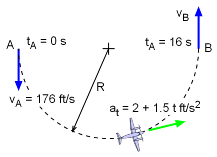| Ch 1. Particle General Motion | Multimedia Engineering Dynamics | ||||||
|
Position, Vel & Accel. |
Accel. vary w/ Time |
Accel. Constant | Rect. Coordinates | Norm/Tang. Coordinates | Polar Coordinates |
Relative Motion |
|
| Curv. Motion: Normal/Tangential | Case Intro | Theory | Case Solution | Example |
| Chapter |
| - Particle - |
| 1. General Motion |
| 2. Force & Accel. |
| 3. Energy |
| 4. Momentum |
| - Rigid Body - |
| 5. General Motion |
| 6. Force & Accel. |
| 7. Energy |
| 8. Momentum |
| 9. 3-D Motion |
| 10. Vibrations |
| Appendix |
| Basic Math |
| Units |
| Basic Dynamics Eqs |
| Sections |
| eBooks |
| Dynamics |
| Fluids |
| Math |
| Mechanics |
| Statics |
| Thermodynamics |
| ©Kurt Gramoll |
|
|
||
| Solution of a) |
||
 Plane Path and Boundary Conditions |
Since the velocity is tangent to the path, the rate of change of the speed is the tangential acceleration. at = dv/dt = 2 + 1.5t ft/s2 The tangential acceleration can be integrated to obtain an equation for the speed as a function of time. Since the plane enters the turn traveling at 176 ft/s, this becomes the lower limit of integration for the velocity, v = ds/dt = 0.75 t2 + 2 t + 176 Substituting the time required for the plane to complete the turn, the speed at B becomes vB = 0.75 (16)2 + 2 (16) + 176 = 400.0 ft/s |
|
| Solution of b) |
||
|
|
The velocity equation above can be integrated to obtain an equation for the displacement s as a function of time. s = 0.25 t3 + t2 + 176 t Again substituting the time required, the distance traveled during the turn is obtained as s = 0.25 (16)3 + (16)2 + 176 (16) = 4,096 ft Since the plane travels in a semicircular path and the total distance traveled is now known, the radius of of the path can be determined as R = 1,304 ft The radius of curvature is a constant equal to the radius of the semicircular flight path: ρ = R = 1,304 ft |
|
 Acceleration in the Normal Direction over time (expresses as g's) |
The maximum centripetal acceleration occurs at point B, where the speed v is a maximum, an = v2/ρ = v2/R = 4002/1,304 = 122.7 ft/s2 The acceleration of gravity on Earth is constant at 32.2 ft/s2. At 122.7 ft/s2, the maximum centripetal acceleration that the plane experiences is approximately 4 times that due to gravity. It is unlikely that a cargo plane would execute such a "high-g" turn. |
|
